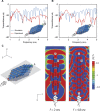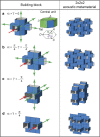Reconfigurable origami-inspired acoustic waveguides
- PMID: 28138527
- PMCID: PMC5262461
- DOI: 10.1126/sciadv.1601019
Reconfigurable origami-inspired acoustic waveguides
Abstract
We combine numerical simulations and experiments to design a new class of reconfigurable waveguides based on three-dimensional origami-inspired metamaterials. Our strategy builds on the fact that the rigid plates and hinges forming these structures define networks of tubes that can be easily reconfigured. As such, they provide an ideal platform to actively control and redirect the propagation of sound. We design reconfigurable systems that, depending on the externally applied deformation, can act as networks of waveguides oriented along one, two, or three preferential directions. Moreover, we demonstrate that the capability of the structure to guide and radiate acoustic energy along predefined directions can be easily switched on and off, as the networks of tubes are reversibly formed and disrupted. The proposed designs expand the ability of existing acoustic metamaterials and exploit complex waveguiding to enhance control over propagation and radiation of acoustic energy, opening avenues for the design of a new class of tunable acoustic functional systems.
Keywords: Acoustic waveguide; metamaterial; origami; reconfigurable; sound.
Figures







References
-
- Selamet A., Dickey N. S., Novak J. M., The Herschel–Quincke tube: A theoretical, computational, and experimental investigation. J. Acoust. Soc. Am. 96, 3177–3185 (1994).
-
- Poirier B., Maury C., Ville J.-M., The use of Herschel–Quincke tubes to improve the efficiency of lined ducts. Appl. Acoust. 72, 78–88 (2011).
-
- Depollier C., Kergomard J., Lesueur J. C., Propagation of low frequency acoustic waves in periodic 2D-lattices of tubes. J. Sound Vib. 142, 153–170 (1990).
-
- Molerón M., Félix S., Pagneux V., Richoux O., Sound propagation in periodic urban areas. J. Appl. Phys. 111, 114906 (2012).
-
- Lang R. J., Origami: Complexity increasing. Eng. Sci. 52, 16–23 (1989).
LinkOut - more resources
Full Text Sources
Other Literature Sources
Research Materials

